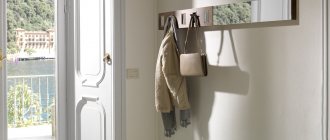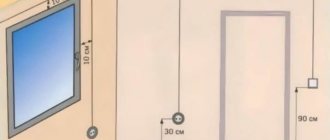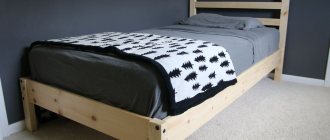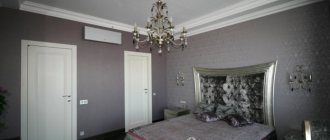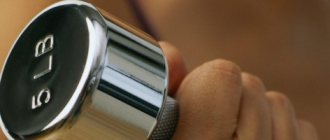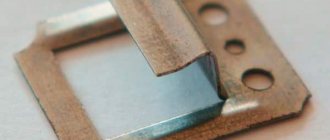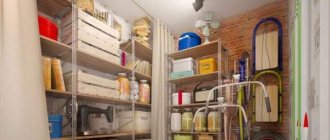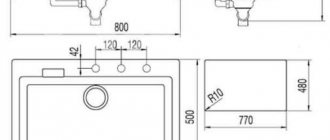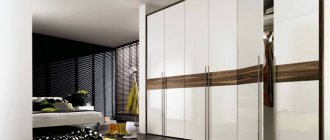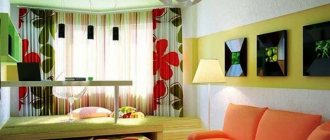Types of fastenings
To attach the shelf to the wall, you can use:
- exposed (visible) fasteners;
- hidden fasteners that are invisible to the average person.
Exposed Fasteners
Open fasteners include:
- brackets of various configurations and sizes. It is recommended to use such a shelf fixing element only if it fully matches the design of the room;
- metal corners. Devices are the simplest, most common and reliable elements. Can be installed in rooms with any finish;
- loops. They are also a common option. Easy to install and reliable;
- holders. Used advantageously as fastenings for glass shelves. Can be of different shapes, colors and different sizes.
Hidden fasteners
Fixation with hidden fastening is carried out using:
- hidden. A special structure is installed inside the shelf, which rests on a bolt screwed into the wall. From the front side, neither the hinge's retaining hole nor the bolt are visible;
- metal rods that are attached to the wall and “recessed” inside the shelf.
How to install a shelf mount: basic nuances
Before you begin installing the fasteners, you should make sure that the support is thick enough to match the weight and dimensions of the shelf being installed. You can use a wooden strip as a template for drilling holes for fastenings. It should be placed on the back side of the shelf, making small holes in the places where the fasteners are installed. This way you can avoid mistakes when creating holes for fasteners in the wall.
Then you can proceed directly to drilling. It is extremely important to remain as precise as possible here, especially if drilling occurs in several stages. The initial holes should be made with a drill of a minimum diameter, and only then expanded to the required size.
If fastening for shelves requires screwing in large-diameter anchor bolts, in this case it is better to carry out such work using an electric screwdriver. An excellent way to securely fasten bolts are threaded couplings. Installation of such fastenings contributes to the longest possible operation of wall shelves without the need for repairs.
Installation of fasteners
Installation of fastening the shelf to the wall with your own hands is carried out according to the following algorithm:
- choice of fastenings;
- preparation of instruments;
- fixing the shelf to the wall.
Selection of fasteners
When choosing fasteners, consider the following parameters:
- the material from which the wall is made. You can hang shelves on brick and concrete walls in any way. For plasterboard walls, it is recommended to select stronger fasteners;
If the wall is sheathed with plasterboard or other finishing material, then the shelf should be attached exclusively to wooden blocks, other devices holding the sheathing or the main wall.
- the material from which the shelf is made. Massive fasteners are not suitable for glass shelves, as they make the structure too heavy. For metal shelves, external fasteners are best, and for wooden shelves, internal fasteners are best;
- thickness and other overall dimensions. For massive shelves, it is recommended to select similar types of fastenings: large brackets, hidden metal rods, and so on. For light, thin shelves intended for storing souvenirs, cosmetics, and so on, it is advisable to use small corners.
Additionally, it is worth considering the number of fasteners. If brackets, corners or hinges are used, their number cannot be less than 2 pieces, located on each side of the shelf. If the shelf length is more than 1 - 1.5 m, it is recommended to increase the number of fasteners.
Preparing tools
To complete the installation work, you will need to prepare the following list of tools:
- ruler, tape measure and marker for marking;
- building level for leveling in a horizontal position;
- drill. If installation is being carried out on a brick or concrete wall, then it is recommended to use a hammer drill instead of a drill;
- screwdriver or screwdriver, hammer;
- dowels, screws and other fasteners.
Shelf fastening
The instructions for attaching the shelf are as follows:
- At the first stage, it is necessary to determine the place where the shelf will be hung and mark the location of the fastening elements. When applying markings, it is important to take into account the horizontal level of the piece of furniture, since otherwise it will be impossible to put anything on the shelf;
- hole preparation. Before attaching the elements fixing the shelf, it is recommended to pre-drill the holes, even when attaching to a wooden wall;
Preparing the holes will allow you to eliminate even the slightest deviation from the given level and hang the shelf as straight as possible.
- installation of dowels. If the shelf is hung on a brick or concrete wall, then before fixing it with self-tapping screws, it is necessary to install plastic dowels, which allow for a stronger adhesion of the fastening element to the wall. Dowels can simply be hammered into the holes;
- fixing the selected mount to the wall using self-tapping screws of a suitable length;
- fastening the shelf to the bracket. If fixation is carried out using hidden metal rods, then before fastening it is necessary to drill holes in the shelf of appropriate size and length;
- checking the correctness of the work. At this stage, it is necessary to check the reliability of the shelf fastening, applying the maximum permissible force to the piece of furniture (for example, you can lean your elbows or hang slightly on the shelf) and the horizontal installation using a building level.
How to install a shelf with hidden fastenings, watch the video.
To secure the shelf, you can use other completely different objects, for example, thick leather belts. Unusual types of fastenings will add individuality to the interior of the room.
The hidden shelf is a decorative accent that creates the illusion. The shelf seems to “float” on the wall. By adding such furniture to the interior of your living room, bathroom, kitchen, bedroom, you can solve the problems of storing books, necessary accessories or souvenirs. Such furniture is often required to decorate children's rooms, which have a lot of tiny cars, dolls or other toys. “Floating” shelves are cheap, beautiful, keep everything safe on them, and it takes little time to make such furniture.
How to hang a shelf evenly using electrical tape and a level
How to hang a shelf level using electrical tape and a level.
The first thing you need to do is decide where the shelf will hang. Consider several important points at once: the shelf should not be located too high so that it is convenient to take things from it, and it should not interfere with you in the room.
Once you decide on the “where to hang?” question, move on to the “how to hang?” part. If you have a brick wall, then for measurements you can use electrical tape, which can be easily glued to the wall and then removed. To accurately mark the points where you need to screw in the screws, we recommend that you first measure the distance between the hinges on the shelf, and then cut a piece of electrical tape of the same size.
We measure the length of the electrical tape.
We screw the screw in the right place.
We invite you to familiarize yourself with the Rules of the steam room in a Russian bath
Now all that remains is to drill holes close to the electrical tape with a drill, hammer in the dowels and screw in the screws. After peeling off the tape, you can safely hang the shelf!
The shelf hangs on a brick wall.
Types of fastenings
The inconspicuous fastening that supports the shelf has a wide range of varieties:
- Alcoves and niches are a convenient place to mount shelves because they can easily be mounted on three walls at once.
- The hidden bracket with two slots is convenient because it can be used anywhere.
- Invisible fasteners made of durable metal with alloy steel connecting screws create tension between the posts. This gives them impressive support ability. If a longer shelf is needed, additional supports are added. Invisible fasteners can be used to create heavy-duty floating shelves.
Rustic Bathroom Shelves
If it's time to modernize your interior, shelves with hidden fastenings in the Provence style are the perfect decor. She creates exclusively her own, unique home comfort. And at the same time it seems to be floating in the air! Its artsy yet simple appearance will brighten up the bathroom and any nook that needs storage space.
This shelf model installs as a floating shelf and is reinforced for added strength, making it a great storage option for collectibles, photos, keepsakes and glassware. The design is inexpensive and requires very few materials.
Tools:
- level,
- measuring tape,
- saw,
- drill.
Consumables:
- tree,
- screws,
- optional finish.
Advice. You should avoid last-minute shopping trips; it is better to prepare materials in advance.
Creation algorithm
- To make hidden shelves with your own hands, first draw a sketch; this will help you understand the design and find out what type and size of wood is needed. The step also includes measuring the width of the space from wall to wall.
- The next step is to create a special frame. You can use liquid nails to glue the frame together first, and then use screws and angle iron to hold all the pieces together.
- Next, the boards are painted or painted, which will then be fixed to the frame. You can use the same paint or varnish that has already been used on other furniture. It's nice that today there are varnishes available that will make wood look old in a matter of minutes and highlight its texture, such a finish is great for a rustic style.
- The desired height of future shelves is measured and the support frames are attached to the wall. Before drilling, the wall is checked using a detector for the presence of wires and pipes.
- Next, you need to make sure that the invisible shelf is level. After all, it is quite difficult to find beautiful boards that are quite straight. If it turns out that the boards are uneven, proceed to step 6.
- Spacers are added to level the shelf. This step is repeated for the top and bottom boards.
- Then the top board is glued to the frame using liquid nails.
- The bottom board is much more difficult to fix with liquid nails, so it is better to secure it with screws.
- The front part of the shelf is glued last.
Attention! The walls of the room are painted before attaching the shelves. Instead of boards, you can use MDF.
Hidden shelves from old drawers
These shelves are made from 2-8 drawers, not necessarily matching in color, shape or size.
- The drawers are cleaned and unnecessary parts are removed. Surfaces are sanded.
- Then the protruding edges of the cladding are cut off so that the entire side of the bottom fits tightly against the wall.
- The inside of the drawers is painted to match the color of the wall. This will create the illusion of floating shelves.
- Next, the boxes are laid out on the floor to find beautiful compositions to determine the places where they will be attached. The composition you like is photographed; this photograph will replace the sketch.
- According to the plan, wooden supports are mounted on the wall. Make sure they are level.
- The boxes are placed on supports and secured with screws (the screws are painted over if they need to be hidden).
Decorative handles or accessories can be added if desired. Another idea is to attach decorative “note paper” to the inside of drawer-turned-shelves.
Shelves-tubes for toys
- The buckets are cleaned, the labels are removed, and the top is cut off (use a hand or electric saw).
- Future shelves are painted on the outside with plastic paint.
- Then two holes are made for the screws.
- The structure is fixed on the wall.
And, voila, the furniture is ready! This DIY shelf is an economical idea for creating storage space for small items.
Designers use a lot of techniques and create a unique and unique environment in modern apartments. And one of the very significant interior items can be called wall shelves. This furniture is presented in a wide range on the market. You can store books, dishes, various figurines, jewelry and other small items on it. Moreover, such furniture is used not only in apartments and private houses, but also in office rooms. And that is why we decided to talk about shelves with a hidden type of fastening and the dismantling of such products.
Bookshelves
There are strength requirements for bookshelves: they can hold significant weight.
Therefore, the fastening, materials and design must be reliable. Traditionally, bookshelves are made of wood, laminated or veneered fiberboard. And then fiberboard with a long span (more than 90 cm) sag over the years. When planning shelves for books on the walls according to your own dimensions, keep in mind that the distance between the supports should not be more than 90 cm. Then even when fully loaded it will not bend. There are two types and varieties of shelves: wall-mounted and floor-mounted. Both of them can be angular.
In the simplest case, it is a board secured in one of the following ways. Some options, especially when presented correctly, look very good.
The simplest design of a shelf at the bottom of a wall for books (a secret fastening is used)
And with imagination, several planks turn into a very interesting thing, which can even be the main element of decor. Ideas for DIY are collected in the photo gallery.
And this is a serious way to expand the space due to the corners between two windows. A very interesting idea of using corners for small shelves. Corner wall shelf for books. Attached to pelicans)) Due to the contrasting color, this shelf is the center of attention Nothing complicated: it’s easy to assemble such a bookshelf with your own hands, and the look is non-standard Non-linearity - they are always interesting, and books of different heights can be placed on such a shelf Small system with jumpers made of pipes
Floor bookshelves can be loaded more seriously. Here the forms are different: there are racks to which shelves are attached. The highlight can be a broken or unusual line of shelves, as well as interesting racks.
A simple design benefits from color and lintels. Unusual racks decorate this floor-standing bookshelf. It’s more like a bookcase or even a cabinet, but the essence does not change - the original color and interesting small shelves in the central part and the structure looks interesting. Easy to make, and original. Very interesting. the idea is non-linear shelves and lintels made of thick glass. This is more of a system of shelves
Read about the manufacture of fountains (both small indoor ones and more substantial ones for a country house, personal garden or garden plot) here.
Features of hidden fasteners for shelves
The choice of this mounting option is often determined by the style in which the room is decorated. This installation method is a rather labor-intensive process, which is why it is chosen only when there is a serious need for it. This type of installation helps to create a feeling of lightness of the structure and visually increase the space in the room.
This installation option is usually used in minimalism and hi-tech style. By giving it preference, you can hide all the fasteners, as a result of which the installed structure will acquire an elegant appearance.
Important! It is not recommended to attach shelves in this way to plasterboard partitions whose thickness is less than 1 cm.
Methods for attaching shelves to the wall
There are many ways in which you can attach shelves to the wall. However, you should dwell only on a few of the simplest, most accessible and convenient methods. Among them are:
Traditional fastening for shelves involves the installation of various brackets, wooden and metal racks. However, installing shelves on racks in this case seems rational only if the design of such supporting elements matches the features of the interior.
Noticeable progress in translating the most daring design ideas into reality, along with the development of the construction industry, makes it possible not only to quickly select suitable fastenings for installing wall shelves, but also to create the illusion of them “hovering” in space, carefully hiding the fastening elements. Thus, hidden fastening of the shelf is possible if there are brick, plasterboard or cinder block walls with a thickness of at least 10 cm. Otherwise, the shelves can be used exclusively as a decorative element.
How to remove shelves with hidden fastenings
All work on dismantling a furniture product installed using the presented method can be done by any consumer himself. At the same time, he will not need to have special knowledge and skills. You just need to stock up on special tools and follow the special instructions that will be presented in the material below. And if there is a fear of violating the integrity of the structure or causing visible damage to it, it is best to entrust this work to specialists.
What tools will you need?
To perform the work you will need a minimum set of tools, namely:
- hammer;
- pliers;
- screwdriver;
- screwdriver
Removing shelves with hidden fastenings: step-by-step guide
Installing a shelf using a hidden fastening method involves drilling holes in the wall, installing metal rods in them and then placing the product on them. Accordingly, the dismantling algorithm will look as follows.
- First, you will need to dismantle the shelf itself by removing them from the iron rods.
- Afterwards, you need to remove the metal sticks using pliers.
Important! When installing the holes for placing sticks, it is recommended to fill them with resin, which is why during dismantling you may need not only pliers, but also a hammer to loosen the part.
- Afterwards you will need to remove the hanging bracket using a screwdriver or screwdriver.
- If the shelf is not planned to be installed in this place in the future, you will simply need to seal the remaining holes to give the wall an attractive appearance.
Now, when dismantling shelves with hidden fastenings, you will not damage the wall, and you will remove the products with precision and care.
There is nothing better than shelves for organizing space in rooms, as well as for decorating the interior. Comfortable, functional, original in shape, they help to conveniently arrange a lot of things and give the rooms a more comfortable look. Making shelves on the wall with your own hands is not at all difficult, and you can use a wide variety of materials - wood, fiberboard, glass, pieces of tin, plywood.
| Types of Wall Shelves | Description |
| Classic | This type of shelves is the most common due to its simplicity, aesthetic appearance and ease of installation. They represent a huge flight of fancy: from simple square to creative asymmetrical shapes |
| Corner | This type of wall shelves differs in the method of fastening - it is carried out on adjacent adjacent walls. Most often they are installed in utility rooms and bathrooms. |
| Hanging | This original way of creating a shelf involves attaching a simple structure to the ceiling using cables or vertical posts. |
| Floor-standing | This wall shelf is a floor support design. This type of product is especially relevant in hallways, as well as large rooms, where you don’t have to think about wasting space. |
| Open and closed shelves on the wall | Wall shelves can be designed, for example, with or without glass |
To the nursery
While the child is very small, I want functional shelves, but with children's drawings. But where can you get these? Do it yourself. Any shelf of the configuration you like can be covered with non-woven wallpaper or thick wrapping paper (glued with PVA). After drying, coat twice with water-based varnish.
Here's what can happen
For children, the shelves are not very different in design. If we talk about floor or shelving, then they must be strong, taking into account the fact that older children will definitely want to climb on them. Therefore, often even those shelves that stand on the floor are additionally attached to the wall: so that they do not collapse and crush young climbers. Based on these considerations, they are not made tall: even if they fall, it’s not scary.
The shelves in the children's room also differ in color - they are brighter, can be made in the form of letters, and boxes for toys can be installed in them: this makes it easier to keep them in order. In general, functionality and security must be combined.
System with drawers - cleaning will be quick Children grow, design and colors change Combination of open and closed shelves - convenient for preschoolers Fairytale town will appeal to both boys and girls
Read about developing a children's room design here.
Making a simple wooden shelf
Wood is the most convenient material to work with. Wooden shelves come in simple, complex shapes, open and closed, vertical, horizontal and corner. Taking the basic option as a basis, you can assemble a shelf from several modules and give it the most incredible look. In order for the product to serve for a long time, you should choose the right wood: the boards must be perfectly flat, completely dry, without cracks, voids or traces of mold.
During the assembly process you will need:
- hacksaw;
- drill;
- building level;
- pencil and ruler;
- boards 16 mm thick;
- stain;
- wood varnish;
- sander;
- screws, brackets, dowels.
The example used is a simple rectangular shelf 250mm wide, 300mm high and 1100mm long.
Step 1. Marking
The boards are laid flat on the table and the measurements are transferred from the drawing. The height of the side walls should be 268 mm, since they will be located between the top and bottom: wall height + board thickness x 2 = 300 mm.
Step 2. Cutting the boards
If the markings exactly match the diagram, you can start cutting. It is best to use a jigsaw for this, then the cuts will be perfectly smooth and neat. You should end up with 2 long pieces and 2 short ones.
Step 3. Processing of blanks
Before starting assembly, each workpiece must be sanded, stained and varnished. If you plan to simply paint a shelf, the blanks are processed - this increases their service life and makes the paint apply more evenly.
Step 4. Assembling the product
The bottom board is laid flat on a flat surface. From the ends of the workpiece, retreat 8 mm and draw 2 straight lines parallel to the cuts. Now on these lines you need to mark two points at a distance of 5 cm from the edge, and drill holes there for the screws. The same is done with the top blank. When all the holes are ready, install the side blanks on the bottom board and tighten the screws. Place a second board on top and also fix the side walls with self-tapping screws.
Brackets are attached to the ends of the side walls, holes are drilled in the wall for dowels, self-tapping screws are inserted and tightened so that they protrude by about 5 mm. The dowels must be positioned strictly horizontally, so before drilling, mark a line using a level. Now all that remains is to attach the brackets to the fasteners and hang the shelf. If desired, the back wall of the product can be filled with a piece of plywood, and glass can be inserted in front.
To make such a simple shelf more original, you can replace one side wall with a stump of a thick branch. To do this, choose an even branch with a diameter of about 7-8 cm with smooth, clean bark, saw off a piece 28 cm long, and cut off all the side shoots. The chock is treated with a primer, dried and varnished. There is no need to remove the bark. After the varnish has dried, the workpiece is inserted between the upper and lower boards and screwed tightly with self-tapping screws.
Based on this drawing, you can make various variations of wall shelves. For example, reduce the length to 400 mm and make 3-4 blocks at once. Then install them on top of each other in a checkerboard pattern and secure them together using metal plates. Or simply mount them on the wall separately, placing them at a short distance from each other.
Often, to save space, shelves are made corner, and they can be mounted both in the inner and outer corners.
The blanks are made according to the scheme described above, only the upper and lower boards consist of two elements, with the ends cut at an angle. The process of making such a shelf is quite simple:
- the halves of the top board are coated at the ends with glue and clamped with clamps;
- repeat the same actions with the bottom board;
- when the glue dries, all workpieces are covered with stain or primed;
- Attachment lines are marked on the upper and lower workpieces and holes are drilled;
- insert the side walls and secure them with self-tapping screws.
| Wall shelf materials | Advantages and disadvantages |
| Wood: plywood, chipboard, MDF and others | This material is relatively easy to work with, it looks beautiful, natural and impressive, its service life is quite long, especially if pre-processed |
| Plastic | This material is the most versatile; it can imitate both wood and stone, while eliminating their shortcomings |
| Metal | Such wall shelves will be very strong, reliable and durable, but they will hardly fit into a classic interior. In addition, corrosion can also be a problem, so metal products will require special processing and conditions |
| Glass | Transparent wall shelves will create an atmosphere of lightness and comfort in your home. Of course, it will be quite difficult to make a glass structure with your own hands, but if you nevertheless decide to do all the work yourself, then you will have to work with glass for quite a long time and very carefully, especially if various cutouts are planned in the shelf design |
Original shelves for books
Shelves of non-standard shape are in increasing demand, so if you wish, you can try to assemble something original. For example, a bookshelf in the form of a simplified labyrinth is used.
To make it you will need:
- edged board 20 mm thick;
- wood glue;
- clamps;
- roulette;
- hacksaw;
- miter box;
- Sander;
- stain;
- furniture screws, self-tapping screws;
- decorative shelf holders.
If you have everything you need, you can start making the shelf.
Step 1. Marking
On the prepared boards, mark the cut lines with a pencil under a ruler. Measurements should be taken very carefully, since all horizontal parts have different lengths.
Step 2. Trimming the blanks
The ends of each workpiece are cut at an angle of 45 or 90 degrees. The diagram shows the first option, so you will need a miter box for sawing. It is very important to correctly install the miter box on the board so that the cuts are symmetrical. If the ends are cut off incorrectly, you will not be able to fold the shelf.
Step 3. Assembling the structure
The ends of the parts are smeared with glue, pressed tightly and additionally secured with slotted furniture screws. Ordinary self-tapping screws are not suitable here. Each joint will require at least 2 screws. Both parts of the shelf are applied to the wall, leveled and the attachment points are marked with a pencil. After this, holes are drilled for the dowels, brackets are screwed to the shelf with self-tapping screws and the structure is hung on the wall. Instead of brackets, decorative pelican shelf holders are often used.
How to hang a shelf without fasteners
How to hang a shelf without fasteners.
A shelf without corners and brackets can be hung in the corners of an apartment or house, and, you see, there are a majority of such places. First you need to mark the place where the shelf will be located, then check whether the shelf fits tightly to the wall.
We drill holes in the wall.
The next step is to drill four holes for the dowels. In order for the shelf to withstand heavy loads in the future, you need to screw in the internal screws 2-3 mm lower than the external ones.
Internal screws should be located 2-3 mm lower than external ones.
Next, grind or bite off the head of the screw or dowel with pliers and drive these screws into the holes so that the tenons are on the outside.
The spikes will serve as fastening for the shelf.
Now you need to place the shelf on top of the spikes, and mark their location on it with a pencil. After this, we move the shelf around the outer short corner, and also mark the extreme position of the tenons with a pencil. We obtained the trajectory of movement of the projection of each spike. We combine the middle of the shelf width and the projection of the grooves for these tenons; here you need to drill neat holes.
We mill out the grooves of the hole using the edge of the drill.
We hang a shelf.
A shelf with such fastening can withstand heavy loads.
Hanging shelf with straps
If you need a decorative shelf for small items, the following option is perfect - a board suspended on straps.
To make a shelf you will need:
- 2 edged boards 300x750 mm, 30 mm thick;
- 4 leather belts, 75 cm long;
- 4 long screws with plastic dowels;
- 4 short screws;
- building level;
- ruler;
- sharp knife;
- drill.
Step 1: Preparing the belts
The cuts of the belts must be perfectly even, so if necessary they are trimmed with a knife. Fold each belt in half, press the ends to the table, step back 2 cm from the edge and drill a neat through hole with a drill. The same is done with the remaining three.
Step 2. Attaching the straps to the wall
Using a level, two points are determined on the wall at a distance of 60 cm. Holes are drilled and plastic dowels are inserted. The belt folded in half is applied to one of the holes and secured with a long screw - you get a large loop on the wall. Another such loop is attached nearby.
Step 3. Installing the shelf
A sanded board is inserted into the loops and aligned horizontally. To prevent the shelf from moving, the parts of the belts adjacent to the wall near the board itself are screwed with short self-tapping screws. Now another shelf is hung under this shelf, exactly repeating the steps described above. The result is a light and neat two-tier shelf. If desired, you can add another 1-2 tiers.
To make the shelves described above, you can use not only wood, but also plywood, as well as laminated chipboard sheets. The last option is used most often, since laminated chipboard is lightweight, high strength, practicality and durability. When assembling shelves from this material, all sections must be covered with a melamine edge to match the color of the sheet.
Shelves and shelves for the kitchen
Say what you like, but in the kitchen the main thing is functionality. There is not much free space even on the walls: the cabinets take up a large area. Therefore, one of the tasks is to make the most of free space. There are interesting ideas for small or even very small gaps between the wall and the refrigerator or other household appliances. Strictly in size, you can make a pokka on wheels, which can be pulled out and completely hidden there. It is wide and narrow (see photo).
It’s easy to make such a retractable shelf-rack on wheels for different jars. Everything you need is at hand and out of the way
There are also interesting ideas for saving space. If the sink or station is located near the window, you can take the sides. There is an interesting hanging option - a grid on chains to which all sorts of utensils are attached. But such a shelf is possible if the desktop is not against the wall. Another option for saving space is if the kitchen-dining room is zoned with a counter, you can also make a shelf above it, which will be partially hanging. One part of it rests on the wall, the second on the counter or “hangs” on the ceiling.
We take up all the free space Shelves near the window in a different style Hanging shelf for small items There is also unused space above the counter
Read about ways to arrange kitchen furniture here.
Covering the entire wall above your desk with cabinets is not the best solution. They look heavy. The problem can be solved by using glass doors, but not everyone likes this. The solution is to make open shelves between the cabinets. They will add more lightness to the interior and the work area will not put so much pressure on the rest of the space.
Glass and open shelves will “lighten” the interior Stylish accessories will not hurt There is also a place for glasses The style is different - the idea is the same Closed and open shelves in one system - convenient and non-standard We invite you to familiarize yourself with Finishing stoves with tiles, decorative stones, tiles, tiles
Making a glass shelf
Glass shelves fit harmoniously into any interior, and the installation process does not take much time. To work you will need:
- strained glass;
- hammer;
- electric drill;
- building level;
- aluminum profile;
- dowels;
- adhesive tape;
- ruler;
- pencil.
Not everyone knows how to cut glass correctly, and therefore it is better to order the cutting of blanks in a workshop. There they will also grind and polish the edges so that when installing the shelf you will not cut yourself on sharp edges. You can do everything else yourself.
Step 1. Marking for fasteners
The section of the wall where the shelf will hang should be as large as possible. Using a building level, draw a horizontal line on the wall with a pencil. The locations of the fasteners are marked on the line and holes are drilled.
Step 2. Installing profiles
An aluminum profile is applied to the wall surface and the alignment of the fastening marks is checked. Then insert dowels into the holes, attach the profile with one screw and level it horizontally. After this, tighten the remaining screws.
Instead of a drill, insert a bracket screw Screw in the bracket screw Leave the bracket screw protruding from the wall Check the position Place the shelves
Step 3. Attaching the shelf
The rear edge of the glass shelf is covered with adhesive tape. You can use separate spacers made of tape, placing them where the glass will touch the screw heads. The shelf is inserted into the profile, the edges of the profile are covered with protective caps. If two shelves touch on the sides, their edges are fastened with metal fittings.
If you have free time and a desire to experiment, you can create very unusual shelves for the wall from scrap materials. For example, a corner shelf made of plastic pipes looks original. To make it you will need sections of sewer pipes and corner bends. The shelf is attached to the wall with screws and dowels.
Old suitcases and briefcases also make great wall shelves. To do this, they are cut to half their height, covered with plywood at the back and secured to the wall with screws or on brackets.
Drawers from unnecessary bedside tables are quite suitable for making shelves. To give them an elegant look, the boxes should be carefully sanded, primed and painted in bright colors. Then they are leaned against the surface with the back wall, the attachment points are marked and holes are drilled for them. Even one such shelf looks very original, and a composition of 2-3 drawers will become a real decoration.
Video - DIY wall shelves
Decorative and original
Often, shelves on the wall play a purely decorative role. They are designed to attract attention and this goal is achieved by an unusual shape, contrasting with the walls and color. You can’t bet much on it: one or two things, but how interesting they are.
There are only three rectangles, but due to the color and binding they look very stylish. Another option from different rectangles and squares, and even painted in bright contrasting colors. You can’t pass by. A very interesting idea of using corners for small shelves. The theme is the same, the mood is different. And only due to the fact that the contrast between the color of the wall and the color of the shelf is not so bright. Another option for “square” shelves. Two identical sets arranged differently If traditional square shelves are decorated around the edges with curly frames, the style turns out to be completely different
Another interesting topic is glass shelves. Just one glass is not very interesting. Its combination with wood and steel is more attractive. The effects are sometimes unexpected. Glass is assembled on guides: the material is fragile and heavy, and it needs to be held. Steel can do this.
An interesting glass option. You can arbitrarily change the height between tiers
In fact, these systems are intended for creating store interiors, but they also look stylish in an apartment in a modern or loft style.
Also suitable for vintage style
What are shelves made of? Even from pipes. Metal and plastic. Do you have any samples left from the renovation? Put it to work and get a designer item, interestingly, assembled from trash.
This is a floor option. Plastic pipes do not need to be painted. Water pipes, corners, everything is painted with bronze paint. Large diameter plastic pipes installed in a frame. Here's an unusual shelf. Here's an interesting variation of a bookshelf made of pipes
There are examples that simply amaze you. Well, how could you come up with this?
A combination of open and closed shelves. Non-standard shape - rounded corners and a completely new look Forged base looks noble Non-standard corner shelf Can be an interesting partition between zones Something similar can be made from polycarbonate. They come in different colors and bend quite well. A wild flight of imagination from the author. An idea for those who have a lot of books. Interesting design For lovers of cut flowers. Cardiogram shelf...
Interesting wooden shelf. Master Class
You will need:
- Rope;
- Board at least 2 cm thick;
- 2 corners (mounts) for shelves;
- Steel washers;
- Lighter;
- Drill;
- Saw.
As has been said more than once in our blog, methods for attaching shelves can be very diverse based on the load on the shelf, design solutions and its purpose. However, often the interior of a room implies minimalism, and in this case, external fastening may be unnecessary. Hidden fastening becomes preferable.
Stages of attaching a shelf to a hidden mount
1. Assessing the strength of the wall/partition on which the shelf will be installed.
The thickness of a concrete partition from 100 mm or a brick partition of 250 mm is a condition under which a shelf can be installed without additional load-bearing structures, without fear of consequences. With thinner walls or partitions, as well as with plasterboard and cinder block walls up to 100 mm, it is theoretically possible to install a shelf with hidden fastening, but only for decorative purposes with a very small load on the shelf.
2. Selection of a shelf with optimal thickness and depth.
This must be done to ensure that its functionality is fully realized and that the load weight is suitable for its capabilities. For example, the thickness of a book shelf should be from 45 to 60 mm.
3. Selection of fasteners.
If the fasteners are not supplied with the shelf, select them based on the type of wall on which you will hang the shelf.
Which shelf mounts should I use?
To attach racks and shelves, you can use different types of fasteners, depending on the material of the wall on which they are attached.
For walls made of bricks, blocks and other traditional building materials, you can use:
Anchor bolts, the newest and most reliable fasteners. It can withstand significant loads and is even suitable for aerated concrete or foam blocks, which can crumble during operation. In addition, anchor bolts are easy to work with.
Dowels are also a fairly reliable way to attach a shelf. But they have one drawback: under heavy operating loads, the plastic can wear out and the dowel will simply begin to gradually crawl out of the wall. Therefore, dowels are a cheap way to secure shelves with little load. Usually these are shelves that are used to store souvenirs.
